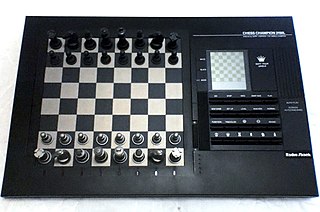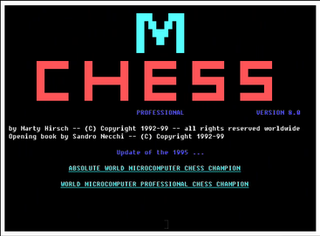
Computer chess includes both hardware and software capable of playing chess. Computer chess provides opportunities for players to practice even in the absence of human opponents, and also provides opportunities for analysis, entertainment and training. Computer chess applications that play at the level of a chess grandmaster or higher are available on hardware from supercomputers to smart phones. Standalone chess-playing machines are also available. Stockfish, Leela Chess Zero, GNU Chess, Fruit, and other free open source applications are available for various platforms.

An evaluation function, also known as a heuristic evaluation function or static evaluation function, is a function used by game-playing computer programs to estimate the value or goodness of a position in a game tree. Most of the time, the value is either a real number or a quantized integer, often in nths of the value of a playing piece such as a stone in go or a pawn in chess, where n may be tenths, hundredths or other convenient fraction, but sometimes, the value is an array of three values in the unit interval, representing the win, draw, and loss percentages of the position.
ChessBase is a German company that develops and sells chess software, maintains a chess news site, and operates an internet chess server for online chess. Founded in 1986, it maintains and sells large-scale databases containing the moves of recorded chess games. The databases contain data from prior games and provide engine analyses of games. Endgame tablebases are also provided by the company.

In computer chess, a chess engine is a computer program that analyzes chess or chess variant positions, and generates a move or list of moves that it regards as strongest.

HIARCS is a proprietary UCI chess engine developed by Mark Uniacke. Its name is an acronym standing for higher intelligence auto-response chess system. Because Hiarcs is written portable in C, it is available on multiple platforms such as Pocket PC, Palm OS, PDAs, iOS, Microsoft Windows and Mac OS X.

Fritz is a German chess program originally developed for Chessbase by Frans Morsch based on his Quest program, ported to DOS, and then Windows by Mathias Feist. With version 13, Morsch retired, and his engine was first replaced by Gyula Horvath's Pandix, and then with Fritz 15, Vasik Rajlich's Rybka.
Robert Morgan Hyatt is an American computer scientist and programmer. He co-authored the computer chess programs Crafty and Cray Blitz which won two World Computer Chess Championships in the 1980s. Hyatt was a computer science professor at the University of Southern Mississippi (1970–1985) and University of Alabama at Birmingham (1988–2016).

Zappa, Zap!Chess or Zappa Mexico, is a UCI chess engine written by Anthony Cozzie, a graduate student at the University of Illinois at Urbana-Champaign. The program emphasizes sound search and a good use of multiple processors. Earlier versions of Zappa are free and the current version is available at Shredder Computer Chess.
Fruit is a chess engine developed by Fabien Letouzey. In the SSDF rating list released on November 24, 2006, Fruit version 2.2.1 had a rating of 2842. In the CEGT rating list released on January 24, 2007, Fruit version 2.2.1 had a rating of 2776.

Rybka is a computer chess engine designed by International Master Vasik Rajlich. Around 2011, Rybka was one of the top-rated engines on chess engine rating lists and won many computer chess tournaments.
The ChessMachine was a chess computer sold between 1991 and 1995 by TASC. It was unique at the time for incorporating both an ARM2 coprocessor for the chess engine on an ISA card which plugged into an IBM PC and a software interface running on the PC to display a chess board and control the engine.
ChessGenius is the name of a chess-playing computer program written by Richard Lang who has in the past written programs that have won the World Computer Chess Championship on 10 occasions.

MChess Pro is the name given to a chess playing computer program written by Marty Hirsch which won the World Microcomputer Chess Championship in 1995. The program is no longer under development and is no longer commercially available and therefore has largely historical significance only.

Stockfish is a free and open-source chess engine, available for various desktop and mobile platforms. It can be used in chess software through the Universal Chess Interface.

Houdini is a UCI chess engine developed by Belgian programmer Robert Houdart. It is influenced by open-source engines IPPOLIT/RobboLito, Stockfish, and Crafty. Versions up to 1.5a are available for non-commercial use, while 2.0 and later are commercial only.

Komodo and Dragon by Komodo Chess are UCI chess engines developed by Komodo Chess, which is a part of Chess.com. The engines were originally authored by Don Dailey and GM Larry Kaufman. Dragon is a commercial chess engine, but Komodo is free for non-commercial use. Dragon is consistently ranked near the top of most major chess engine rating lists, along with Stockfish and Leela Chess Zero.

AlphaZero is a computer program developed by artificial intelligence research company DeepMind to master the games of chess, shogi and go. This algorithm uses an approach similar to AlphaGo Zero.

Leela Chess Zero is a free, open-source, and deep neural network–based chess engine and volunteer computing project. Development has been spearheaded by programmer Gary Linscott, who is also a developer for the Stockfish chess engine. Leela Chess Zero was adapted from the Leela Zero Go engine, which in turn was based on Google's AlphaGo Zero project. One of the purposes of Leela Chess Zero was to verify the methods in the AlphaZero paper as applied to the game of chess.

An efficiently updatable neural network is a neural network-based evaluation function whose inputs are piece-square tables, or variants thereof like the king-piece-square table. NNUE is used primarily for the leaf nodes of the alpha–beta tree. While being slower than handcrafted evaluation functions, NNUE does not suffer from the 'blindness beyond the current move' problem.






